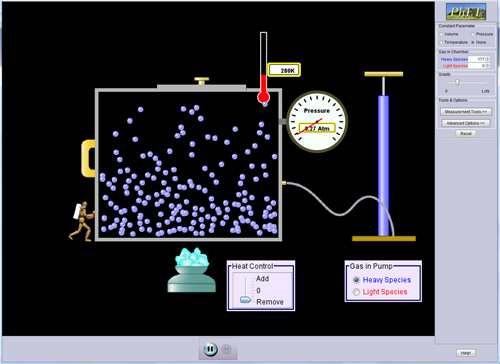
Figure 1: Gas Properties Sim
The Chemistry Education Research community has long recognized the power of animations and visualizations in the teaching and learning of chemistry (e.g. Jones and Smith, 1993; Burke et al., 1998; Tasker, 2005; Jones et al., 2005; Williamson and Jose, 2009; Sanger, 2009; Bishop and Kelly, 2009). Simulations also have the potential to transform the way science is taught and learned, and are increasingly becoming a focus of research. Simulations can be highly interactive and dynamic, make the invisible visible, scaffold inquiry by what is displayed and what is controlled, provide multiple representations, and allow safe (both physically and psychologically) multiple trials and rapid inquiry cycles. Perhaps most important, they make learning fun and engaging. Simulations can be readily disseminated and incorporated into today's classrooms - they are easily distributed over the web, often for free, and can be designed to allow for flexible use that addresses a variety of learning goals.
There is little doubt that simulations will be an ever-growing part of both the educational and scientific enterprise. At this point, the critical question is whether and how educational uses will be highly productive. Measurable benefits will depend on both the quality of simulation design and how they are used.
In this article, we introduce the PhET Interactive Simulations project at the University of Colorado, and describe our growing efforts to create and research interactive simulations for the teaching and learning of chemistry.
With a highly intuitive interface and minimal text, PhET sims are designed to give teachers control over how they are used in the classroom, enabling teachers to customize their use of sims to match their environment and learning goals. This flexibility allows PhET sims to be used in class, in lab or as homework, and with groups or individual students. While PhET sims can be used in a variety of ways, they are specifically designed to make scientist-like, inquiry-based activities productive and fun learning experiences for students.
Our design approach is driven by two overarching goals: 1) to facilitate the development of an expert organizational framework of one's knowledge about the science, and then, recognizing that the development of this framework requires significant mental effort, to 2) provide scaffolding and satisfying feedback in order to make that effort productive and rewarding for students. Many of our design features are illustrated in the Gas Properties and Acid-Base Solutions simulations shown in Figures 1 and 2. These include:
1. Making the simulations highly interactive, engaging, and open;
2. Emphasizing the connection between science and everyday life;
3. Emphasizing productive visual and conceptual models of experts and using physically-accurate, highly-dynamic visual representations of the physics and chemistry with real-time animated response;
4. Building connections between multiple, linked representations;
5. Productively constraining and scaffolding interaction through selection of controls, feedback, and sim structure, while using minimal explicit guidance in the sim (e.g. minimal text); and
6. Reducing cognitive load and making controls intuitive and easy-to use.

Figure 1: Gas Properties Sim
In our research with college science students, we find that well-designed interactive sims allow and attract students to actively engage with the content as scientists do - that is, productively explore a sim through a cycle of self-generated questions where the dynamic, visual feedback from the sim allows students to progressively build, monitor, and correct their understanding as they construct their own mental model of the phenomena. We call this mode of learning Engaged Exploration, and it embodies the process and dynamic nature of science as a discipline (Adams et al., 2008a; Podolefsky et al., 2010). Note that by engaged exploration, we do not mean pure discovery, which may not provide sufficient scaffolding to support productive student inquiry (Kirschner et al, 2007; Hmelo-Silver et al., 2008).
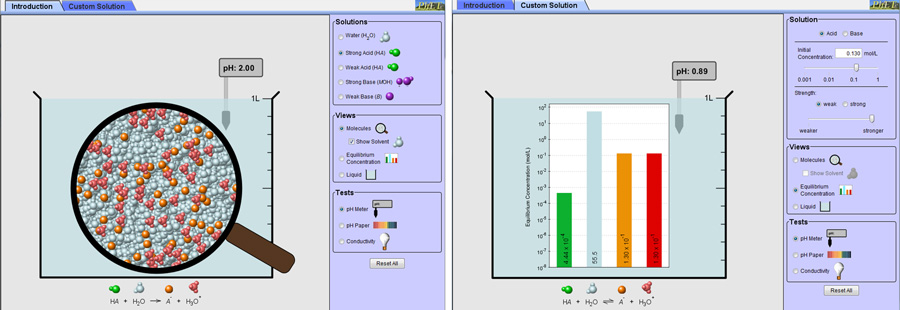
Figure 2: Acid-Base Solutions Sim
PhET sims foster productive exploration through significant implicit scaffolding in terms of what the user can and cannot do as well as what the user is and is not shown (Podolefsky et al., 2010). This scaffolding is built into sims through choice of controls, dynamic feedback, visual representations, etc., and can focus students' attention on the most important aspects of the science, illuminate causal relationships, cue interactions, and reduce cognitive load. Simultaneously, implicit scaffolding provides students the freedom to take multiple productive pathways in exploring the content as their understanding evolves.
While a sim can be honed into a highly effective learning tool, how that sim is used in the classroom is critical. Sims can enhance a well-designed curriculum and the efforts of a good teacher, but they cannot replace them. Issues of classroom context, student motivation and prior knowledge, teacher facilitation, and learning goals all play a role in designing effective simulation-based activities. Identifying and understanding effective approaches to embedding PhET simulations in educational practice is an active area of research for our group and our collaborators.
The Reactants, Products, and Leftovers sim (Figure 3) is designed to address the well-documented student difficulty in translating between the chemical equation and a molecular view of the reaction (Nurrenbern and Pickering, 1987; Mulford and Robinson, 2002). In this sim, folder-like "tabs" along the top are used as scaffolding, with complexity increasing as students move from tab-to-tab in their exploration. The first tab employs the analogy of making sandwiches to help ground student learning in a concrete and familiar context. In the chemical reactions tab, students select among several real-world reactions like making water or combusting methane. Adjustments to the number of each reactant immediately and dynamically change the molecular view representations of products and leftovers. Finally, a game tab - with 3 difficulty levels and options to hide either the molecular or numeric information - provides an opportunity for students to challenge, test, and refine their understanding. For this simulation, interviews established the game as the critical feature for engaging students in developing a robust understanding of limiting reactants.
In the Acid-Base Solutions sim (Figure 2), students can use real-world lab tools to explore how strong and weak acids and bases differ - they can dip pH paper or a probe into the solution to measure the pH, or insert electrodes to measure the conductivity. Students can also use tools not available in lab, such as a magnifying glass that shows the particles in solution. They can elect to show the solvent, which can help dispel the notion that water is continuous. In the second tab, students can use sliders to change both the concentration and the strength of an acid or base. In so doing, they immediately see the effects on the distribution of particles in solution, and thereby develop a conceptual model of acid and base strength.
We have identified 35 existing PhET simulations as relevant for teaching general chemistry or quantum chemistry. Several simulations address topics of electronic energy levels, photon absorption and emission, and photon energies, including Models of the Hydrogen Atom, Neon Lights and Other Discharge Lamps, Lasers, and Photoelectric Effect. The Nuclear Fission, Alpha Decay, Beta Decay, and Radioactive Dating Game sims address nuclear decay and its applications. In addition to being used to address concepts implied by their names, the Salts and Solubility sim and the Reactions and Rates sim can both be used to address the concept of equilibrium. Some other chemistry sims include pH Scale, States of Matter, Greenhouse Effect, and Density.
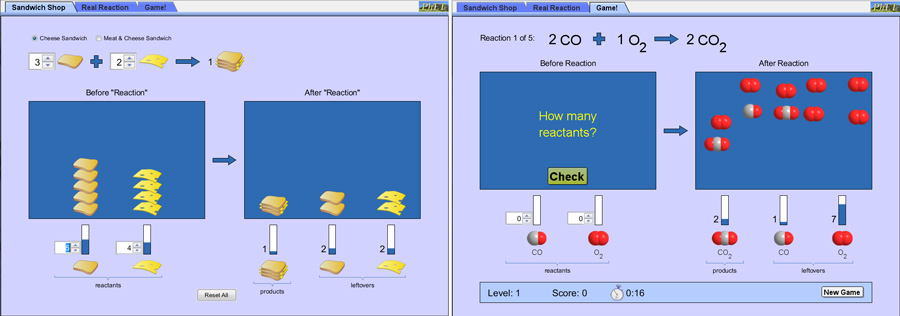
Figure 3: Reactants, Products, and Leftovers Sim
International use of PhET continues to climb. PhET's translation tool makes translating a sim easy for dual-language educators, and we now have sims translated into 51 languages. Not all sims are in every language, but over 2,000 foreign-language sims are hosted on our website. International use now accounts for about 30% of our online simulations use (see Figure 5). In October 2010, we added full translation support for the PhET website, and we now host Arabic and Korean translations of the website and anticipate more languages soon.
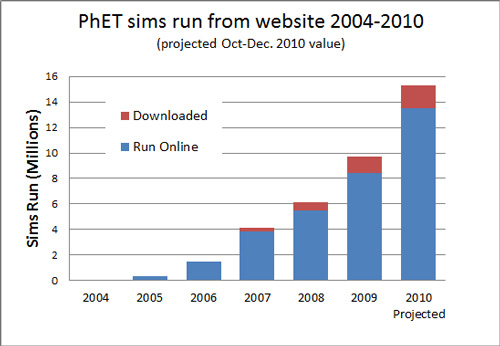
Figure 4: PhET Usage Statistics
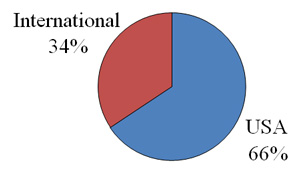
Figure 5: Domestic versus International Use
Adams, W. K., Reid, S., LeMaster, R., McKagan, S. B., Perkins, K. K., Dubson, M., and Wieman, C. E. (2008b). A Study of Educational Simulations Part II - Interface Design. Journal of Interactive Learning Research, 19(4), 551.
Bishop, M. and Kelly, R. (2009). Bound to fail: challenges faced in the design of molecular level visualizations (Paper 6) Committee on Computers in Chemical Education Newsletter (Web): December 7-9, 2009.
Bransford, J., Brown, A.L., Cocking, R.R. and National Research Council (1999). How People Learn: Brain, Mind, Experience, and School. (National Academy Press: Washington, D.C.).
Burke, K.A., Greenbowe, T.A., and Windschitl, M.A. (1998). Developing and Using Conceptual Computer Animations for Chemistry Instruction, Journal of Chemical Education, 75(12)
Clark, R.C. and Mayer, R.E. (2007). e-Learning and the Science of Instruction: Proven Guidelines for Consumers and Designers of Multimedia Learning. (Pfeiffer).
Jones, L.L. and Smith, S. G. (1993). Multimedia technology: A catalyst for change in chemical education, Pure and Appl, Chem, Vol. 65, No. 2, pp. 245-249.
Jones, L.L., Jordan, K.D., and Stillings, N.A. (2005). Molecular visualization in chemistry education: the role of multidisciplinary collaboration, Chemistry Education Research and Practice, 6 (3), 136-149
Kirschner, P.A., Sweller, J. and Clark, R.E (2006). Why minimal guidance during instruction does not work: An analysis of the failure of constructivist, discovery, problem-based, experiential, and inquiry-based teaching. Educational Psychologist 41, 75-86.
Hmelo-Silver, C.E., Duncan, R.G., and Chinn, C.A. (2007). Scaffolding and Achievement in Problem-Based and Inquiry Learning: A response to Kirschner, Sweller, and Clark (2006). Educational Psychologist 42, 99-107
Mulford, D.R. and Robinson, W. R. (2002). An Inventory for Alternate Conceptions among First-Semester General Chemistry Students, J. Chem. Educ. , 79, 739-744.
Nakhleh, M.B. (1992). Why Some Students Don't Learn Chemistry: Chemical Misconceptions, J. Chem. Educ. 69, 191-196.
National Research Council (2005). How Students Learn: History, Mathematics, and Science In the Classroom. (National Academies Press: Washington, D.C.).
Nurrenbern, S.C. and Pickering, M. (1987). Concept Learning versus Problem Solving: Is There a Difference J. Chem. Educ. 64, 508-510.
Podolefsky, N.S., Perkins, K.K., and Adams, W. K. (2010). "Factors Promoting Engaged Exploration with Computer Simulations", Phys. Rev. ST Phys. Educ. Res., 6, 020117
Sanger, M.J. (2009). Computer Animations of Chemical Processes at the Molecular Level, A Chemist's Guide to Effective Teaching Vol 2, Pienta N., Cooper M., and Greenbowe T. eds., Chapter 14, pp. 198-211, Prentice Hall.
Tasker R. (2004). Using multimedia to visualize the molecular world: educational theory into practice. In A Chemist's Guide to Effective Teaching, Pienta N., Greenbowe T. and Cooper M., eds., Chapter 16, pp. 256-272, Prentice Hall.
Williamson, V. and Jose, T.J. (2009). Using Visualization Techniques in Chemistry Teaching, A Chemist's Guide to Effective Teaching Vol 2, Pienta N., Cooper M., and Greenbowe T. eds., Chapter 6, pp. 71-88, Prentice Hall.